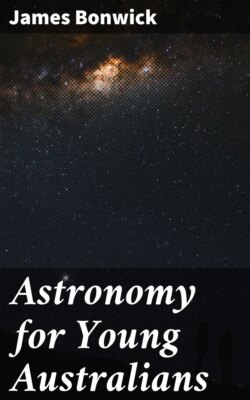Читать книгу Astronomy for Young Australians - James Bonwick - Страница 6
На сайте Литреса книга снята с продажи.
ROTUNDITY OF THE EARTH.
ОглавлениеTable of Contents
It was fine fun for the healthy, hearty English boy to be tossed about in the Great Atlantic. What a noble, towering wave was that which raised up the ship, but only to let it down in the deep trough of the sea, while its crest hung over it, as if to drive it to the bottom!
As the day passed off, and the sombre clouds thronged the western horizon, James got toned down, and became thoughtful and still. Then was his face turned from the waves to the stars, being never tired of watching their motions and admiring their beauty.
He had long been regarding the heavens one evening, when he turned, as he heard his father’s step, and exclaimed—
“The more I study the stars, father, the more their motions bother me.
How is that, my son?
When we first left England I saw the Polar star and Great Bear a good height up in the heavens, toward the north, and Sirius low down toward the south.
Have they been playing any tricks with you?
I do not know that. But as we have been sailing towards the equator, I have observed the Great Bear going gradually down, and Sirius as gradually coming up. I am afraid I shall lose the Polar star altogether soon. And now I have another trouble. I do not know what to make of a number of new stars coming up from the southward.
Would it be owing to the shape of the earth, think you?
Aye, I never thought of that.
If we were sailing on a flat surface all this long way, would you see these ups and downs of the stars?
No, I think not. The truth is, it seems to me that we have been going up a hill, if the stars do not move.
That will account for your Great Bear going down; but what should cause these new stars to appear in the south?
Why, that looks as though we were getting up to the top of the hill, and should have to go down on the other side.
What shape, then, do you suppose the world ought to be, to account for these curious apparent motions of the stars?
I fancy it ought to be round, and that is what I have always been told it is, father.
I want to ask you whether you have noticed anything peculiar about the apparent daily motion of the stars. Do they all rise in the east and pass over to the west?
This is just the subject I wanted to speak about. I thought at first that they did so, and ought to do so. But I have since found out that this is not the case. They do not all describe the same sized circle.
What have you observed?
Some make a regular sweep across—others only rise to pop down again. Yet there is a more wonderful thing. The stars near the North Polar star perform their circle without going under at all. Then the greatest puzzle is, that the Polar star always keeps its place without any turning.
You do not think that the stars describe circles each day of different sizes according to their distances from the Polar star?
No. I feel sure that it is all a cheat of the eye, though I don’t see where the cheat is.
I thought you were quite settled in your mind that the apparent motion of the stars was owing to the revolution of the earth.
True, father; yet I see no connection between the movement of the earth and the stationary place of the Polar star.
What appearance would the heavenly bodies present, were the earth like a big drum rolling over?
Why, I should fancy that then they would all rise in the east and pass over, in an orderly, proper manner, to the west. Though I have been told that the earth is round I do not understand how that should affect the motion of all the stars, as we see them.
Come, let us see. If the world be round, then some parts would describe a less circle than others in the daily revolution.
Of course, father.
Would there be any portion that would not turn at all?
Yes; the poles, or extremities.
Where would be the most motion?
At the equator.
Then, if the stars be still, and the earth move and be round, would not—
O, I know all about it now. The stars over the pole would appear still, because the pole is still. The stars over England would appear to describe a larger circle than those of the Great Bear over Sweden. Where we are now, the stars overhead describe a very large circle.
And at the equator the greatest circle of all?
Yes, yes—and I can now see why the Great Bear seems to go away from us, as we get up the hill toward the equator. That constellation is opposite to a part of the earth a good way to the north of us. As we rise higher from that place, we must appear to rise higher than the stars over it. How I do long to stand under that bright Belt of Orion, and under Sirius! And how I should like to see the pretty Cross stretched over the mast-head!
Wait a bit, my lad, and you may see all these wonders in time.
How delighted I am to make out that all those funny motions among the stars are simply owing to the world being round.”
